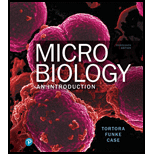
To write:
Many serological tests use the antibodies against the particular pathogen but the Salmonella typhi has three antigens, such as the IgM antibodies production is deficient in nature, and production is made by hybridoma technology.
Given:
Production of antibodies by the Salmonella typhi for the serological test to confirm the presence of antigen in humans.
Introduction:
Salmonella typhi is a gram negative bacteria which is the causative agent for typhoid fever. When it is infected to a person, his immune system produces IgG, IgM and IgA antibodies, since it has three antigens but there is a high specificity in IgM antibody compared to IgG antibody. Widal test often gives false-positive results with other gram negative bacteria.
Want to see the full answer?
Check out a sample textbook solution
Chapter 18 Solutions
Microbiology: An Introduction (13th Edition)
- Noggin mutation: The mouse, one of the phenotypic consequences of Noggin mutationis mispatterning of the spinal cord, in the posterior region of the mouse embryo, suchthat in the hindlimb region the more ventral fates are lost, and the dorsal Pax3 domain isexpanded. (this experiment is not in the lectures).a. Hypothesis for why: What would be your hypothesis for why the ventral fatesare lost and dorsal fates expanded? Include in your answer the words notochord,BMP, SHH and either (or both of) surface ectoderm or lateral plate mesodermarrow_forwardNot part of a graded assignment, from a past midtermarrow_forwardNot part of a graded assignment, from a past midtermarrow_forward
- please helparrow_forwardWhat does the heavy dark line along collecting duct tell us about water reabsorption in this individual at this time? What does the heavy dark line along collecting duct tell us about ADH secretion in this individual at this time?arrow_forwardBiology grade 10 study guidearrow_forward
- Essentials of Pharmacology for Health ProfessionsNursingISBN:9781305441620Author:WOODROWPublisher:Cengage
- Surgical Tech For Surgical Tech Pos CareHealth & NutritionISBN:9781337648868Author:AssociationPublisher:Cengage
 Human Physiology: From Cells to Systems (MindTap ...BiologyISBN:9781285866932Author:Lauralee SherwoodPublisher:Cengage Learning
Human Physiology: From Cells to Systems (MindTap ...BiologyISBN:9781285866932Author:Lauralee SherwoodPublisher:Cengage Learning





